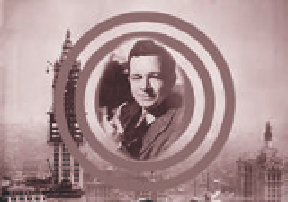Information Technology Reference
In-Depth Information
maintenance man from the Logics Company and their “logic computers” had
much the same capability as one of today's networked personal computers:
You know the logics setup. You got a logic in your house. It looks like a vision
receiver used to, only it's got keys instead of dials and you punch the keys for
what you wanna get. It's hooked in to the tank, which has the Carson Circuit
all fixed up with relays. Say you punch “Station SNAFU” on your logic. Relays
in the tank take over an' whatever vision-program SNAFU is telecastin' comes
on your logic's screen. Or you punch “Sally Hancock's Phone” an' the screen
blinks an' sputters an' you're hooked up with the logic in her house an' if
somebody answers you got a vision-phone connection. But besides that, if you
punch for the weather forecast or who won today's race at Hialeah or who
was mistress of the White House durin' Garfield's administration or what is
PDQ and R sellin' for today, that comes on the screen too. The relays in the
tank do it. The tank is a big buildin' full of all the facts in creation an' all the
recorded telecasts that ever was made - an' it's hooked in with all the other
tanks all over the country - an' everything you wanna know or see or hear,
you punch for it an' you get it. Very convenient. Also it does math for you, an'
keeps topics, an' acts as consultin' chemist, physicist, astronomer, an' tea-leaf
reader, with a “Advice to the Lovelorn” thrown in.
14
B.17.8. Murray Leinster (1896-1975)
was one of the few science fiction
writers to envision the widespread
availability of networked personal
computers. His 1934 novel
Sideways
in Time
is credited as being the first
“parallel universe” science fiction
story. In his 1945 novella
First Contact
Leinster introduced the idea of a
universal translator
, which is still some
way from being a reality.
The story is about one particular logic machine named Joe that developed a
form of intelligence as a result of a small manufacturing error. By giving accu-
rate and direct answers to questions such as “How can I get rid of my wife?”
or “How would I rob my own bank?” Joe causes chaos until he is eventually
located and removed from the network.
By the 1960s computers were becoming a more familiar part of the land-
scape of science fiction and of movies. The original
Star Trek
TV franchise began
in 1966 with creator Gene Roddenberry's vision of a universe-spanning, United
Nations-like organization, the United Federation of Planets (
B.17.9
). The fed-
eration and its Starfleet command pursued a humanitarian, peace-keeping
mission, with a diverse crew of humans and aliens serving in spaceships like
Captain Kirk's Starship Enterprise.
Star Trek
was very much in the tradition of
“space opera” - in which faster-than-light travel through hyperspace is a neces-
sary device to allow interaction between otherwise impossibly distant galaxies.
The focus of each episode was not so much on computers and technology as on
dramatic action and situations - novel computing and communication devices
were just part of the background to the action. Several of these imagined
Star
Trek
devices have now become reality - but not yet the “Beam me up, Scotty”
matter transporter! The handheld, flip-top communications devices used by the
crew of the Enterprise on their off-ship adventures predated today's mobile
phone revolution (
Fig. 17.3
). The
Star Trek
handheld,
tricorder
device incorpo-
rated sensors for data recording and analysis. The tricorder could be used on
off-ship expeditions to explore the unfamiliar locations, examine living crea-
tures, and record and review technical data. On ship, Leonard “Bones” McCoy
used a medical version of the tricorder to help diagnose medical problems and
collect information about his patients. With advances in sensors, digital pho-
tography, and the miniaturization of microprocessors and memory, real-life
versions of the
Star Trek
tricorder will soon be with us (
Fig. 17.4
).
B.17.9. Gene Roddenberry (1921-91)
is best known as the creator of the
hugely successful
Star Trek
franchise.
Before turning to screenwriting,
Roddenberry had a wide variety of
careers, from fighter pilot in the
U.S. Air Force to a stint with the Los
Angeles Police Department. In 1985
he became the first TV writer with a
star on the Hollywood Walk of Fame.



Search WWH ::

Custom Search